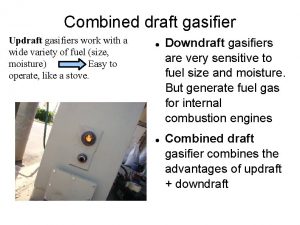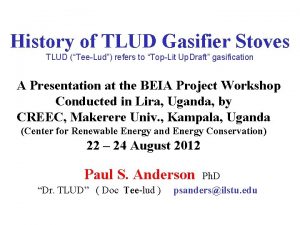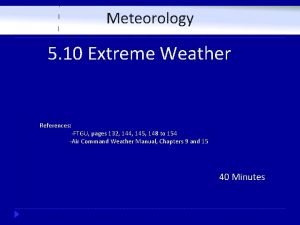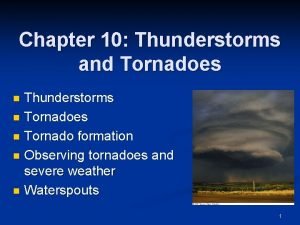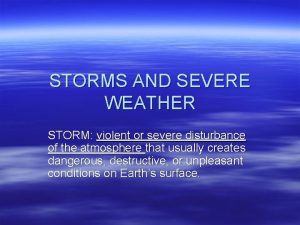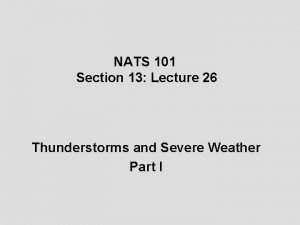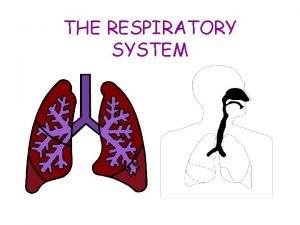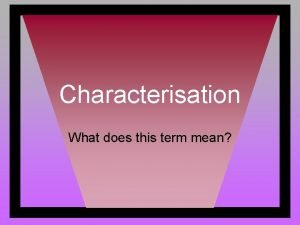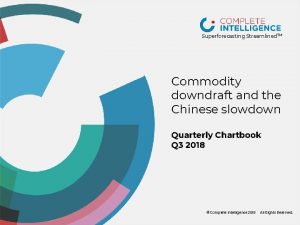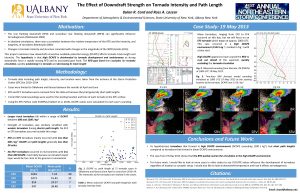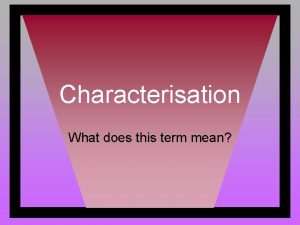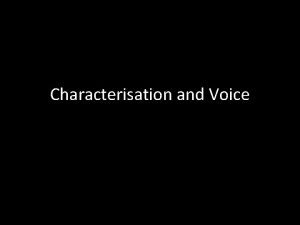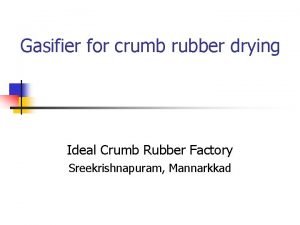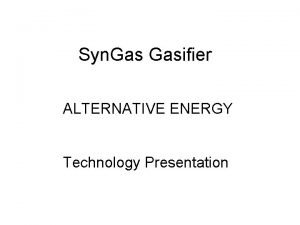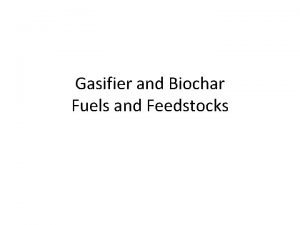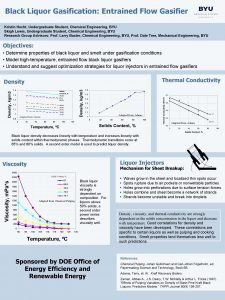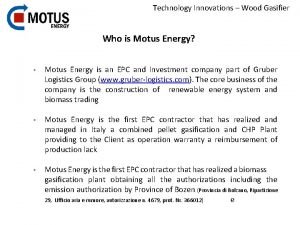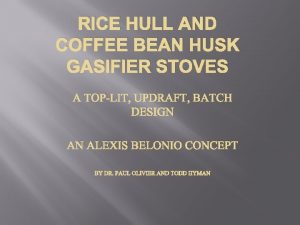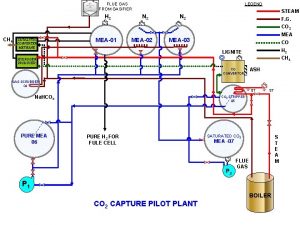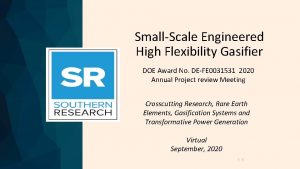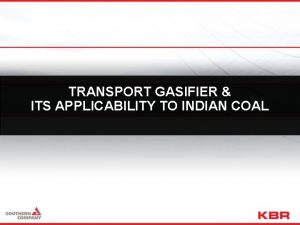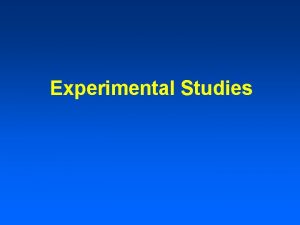Experimental Characterisation of a Downdraft Gasifier Fueled with






















- Slides: 22

Experimental Characterisation of a Downdraft Gasifier Fueled with Woodchar/Woodchips Mixtures 1° Convegno SIBA Salerno, 22 -23/10/07 SOCIETA’ ITALIANA BIOENERGIA E AGROINDUSTRIA F. Pittaluga – University of Genoa DIMSET/SCL – Savona Combustion Lab. pittalug@unige. it - http: //proxy. sv. inge. unige. it/SCL/

Biomass Gasification: Fundamentals Biomass gasification is basically a conversion of solid fuels (wood, wood-waste, agricultural residues, charcoal, etc. ) into a combustible gas mixture normally called Producer Gas. The process is typically used for various biomass materials and it involves partial combustion of such biomass. Partial combustion process occurs when air supply (O 2) is less than adequate for the combustion of biomass to be completed. 1° Convegno SIBA Salerno, 22 -23/10/07 SOCIETA’ ITALIANA BIOENERGIA E AGROINDUSTRIA F. Pittaluga – University of Genoa DIMSET/SCL – Savona Combustion Lab. pittalug@unige. it - http: //proxy. sv. inge. unige. it/SCL/

Biomass Gasification: Fundamentals Biomass is usually composed of the elements carbon, hydrogen and oxygen. In addition there may be nitrogen and sulphur, but since these are present only in small quantities they will be disregarded in the following discussion. In the types of gasifiers considered here, the solid fuel is heated by combustion of a part of the fuel. The combustion gases are then reduced by being passed through a bed of fuel at high temperature. In complete combustion, carbon dioxide is obtained from the carbon and water from the hydrogen. Oxygen from the fuel will of course be incorporated in the combustion products, thereby decreasing the amount of combustion air needed. 1° Convegno SIBA Salerno, 22 -23/10/07 SOCIETA’ ITALIANA BIOENERGIA E AGROINDUSTRIA F. Pittaluga – University of Genoa DIMSET/SCL – Savona Combustion Lab. pittalug@unige. it - http: //proxy. sv. inge. unige. it/SCL/

Biomass Gasification: Fundamentals Oxidation of carbon, or “combustion”, is described by the following chemical reaction formulae (auto thermal gasification): C + O 2 CO 2 - 393. 8 k. J/mol (exo-thermic) C + ½ O 2 CO - 123. 1 k. J/mol (exo-thermic) In all types of gasifiers, CO 2 and H 2 O (vap. ) are converted (reduced) as much as possible to CO, H 2 and CH 4 , which are the main combustible components of producer gas. 1° Convegno SIBA Salerno, 22 -23/10/07 SOCIETA’ ITALIANA BIOENERGIA E AGROINDUSTRIA F. Pittaluga – University of Genoa DIMSET/SCL – Savona Combustion Lab. pittalug@unige. it - http: //proxy. sv. inge. unige. it/SCL/

Biomass Gasification: Fundamentals The most important reactions that take place in the reduction zone of a gasifier between the different gaseous and solid reactants are the following C + CO 2 C + H 2 O CO 2 + H 2 2 CO + 159. 9 k. J/mol (Boudouard, endo-th. ) CO + H 2 + 118. 5 k. J/mol (water gas reaction, endo-th. ) CO + H 2 O + 40. 9 k. J/mol (water gas shift reaction, endo-th. ) C + 2 H 2 CH 4 1° Convegno SIBA Salerno, 22 -23/10/07 SOCIETA’ ITALIANA BIOENERGIA E AGROINDUSTRIA - 87. 5 k. J/mol (methanisation, exo-thermic) F. Pittaluga – University of Genoa DIMSET/SCL – Savona Combustion Lab. pittalug@unige. it - http: //proxy. sv. inge. unige. it/SCL/

Biomass Gasification: Fundamentals Despite the substoichiometric conditions prevailing everywhere, oxidation of CO and H 2 may locally take place according to: CO + ½ O 2 H 2 + ½ O 2 CO 2 H 2 O - 283. 9 k. J/mol (exo-thermic) - 285. 9 k. J/mol (exo-thermic) Though they produce heat, to the advantage of the auto-thermal gasification, they are undesired because the producer gas heat-value is lowered. 1° Convegno SIBA Salerno, 22 -23/10/07 SOCIETA’ ITALIANA BIOENERGIA E AGROINDUSTRIA F. Pittaluga – University of Genoa DIMSET/SCL – Savona Combustion Lab. pittalug@unige. it - http: //proxy. sv. inge. unige. it/SCL/

Biomass Gasification: Fundamentals The equilibrium of above seen “water gas” (heterogeneous) and “water gas shift” (homogeneous) reactions largely govern the final gas composition. On the other hand, the equilibrium composition of the gas will only be reached when the reaction rate and the time for reaction are adequate. Below 700 °C the reaction rates proceed so slowly that the product gas composition is “frozen” : once formed, the gaseous products do not further react with each other. Unfortunately, this applies also to the tars, which build up in the gas, since they cannot undergo any “reduction”. 1° Convegno SIBA Salerno, 22 -23/10/07 SOCIETA’ ITALIANA BIOENERGIA E AGROINDUSTRIA F. Pittaluga – University of Genoa DIMSET/SCL – Savona Combustion Lab. pittalug@unige. it - http: //proxy. sv. inge. unige. it/SCL/

Biomass Gasification at DIMSET/SCL Manufacturer: ANKUR Ltd. located near the ancient “Sama Jakat Naka” Baroda-390008, Gujarat, India web site: www. ankurscientific. com 1° Convegno SIBA Salerno, 22 -23/10/07 SOCIETA’ ITALIANA BIOENERGIA E AGROINDUSTRIA F. Pittaluga – University of Genoa DIMSET/SCL – Savona Combustion Lab. pittalug@unige. it - http: //proxy. sv. inge. unige. it/SCL/

Biomass Gasification at DIMSET/SCL 1° Convegno SIBA Salerno, 22 -23/10/07 SOCIETA’ ITALIANA BIOENERGIA E AGROINDUSTRIA F. Pittaluga – University of Genoa DIMSET/SCL – Savona Combustion Lab. pittalug@unige. it - http: //proxy. sv. inge. unige. it/SCL/

To a Gas Engine Or Gas Turbine Biomass Gasification at DIMSET/SCL Conceptual Sequence of Processes from Biomass to End Products Product Gas Cleaning Equipment 1° Convegno SIBA Salerno, 22 -23/10/07 SOCIETA’ ITALIANA BIOENERGIA E AGROINDUSTRIA F. Pittaluga – University of Genoa DIMSET/SCL – Savona Combustion Lab. pittalug@unige. it - http: //proxy. sv. inge. unige. it/SCL/

Biomass Gasification at DIMSET/SCL Fuel Parameters, Gasifier Performance, Product Gas, Slag, Emissions Monitoring - Physico-chemical characterisation of fuel (woodchips and charcoal-woodchips mix) - Air/Fuel Equivalence Ratio - Inner temperature profile (overall gasifier) - Pressure drop (@ sand filter) - Product gas temperature (@ gasifier outlet) - Water temperature (@ scrubbers) - Product gas flow rate (@ gasifier outlet) - Water pressure (@ scrubbers) - Inner gasifier pressure - Water flow rate (@ scrubbers) - “Clean” product gas chemical composition - Condensate chemical composition - Slag composition and mass flow rate - Condensate mass flow rate ● ● ● - Exhaust gas composition and mass flow rate (@ gas engine outlet) ● - Co-generation thermal power (@ overall equipment and gas engine) ● 1° Convegno SIBA Salerno, 22 -23/10/07 SOCIETA’ ITALIANA BIOENERGIA E AGROINDUSTRIA F. Pittaluga – University of Genoa DIMSET/SCL – Savona Combustion Lab. pittalug@unige. it - http: //proxy. sv. inge. unige. it/SCL/

Temperature Distributions for Varying Fuel Typologies Biomass Gasification at DIMSET/SCL TC 3 Wood@32% hu S-2 Wood@25% hu S-3 TC 2 W@15% Coal TC 1 S-4 W@30% Coal TC 4 HEARTH LOAD OPTIMISED FOR MINIMUM TAR CONTENT 1° Convegno SIBA Salerno, 22 -23/10/07 SOCIETA’ ITALIANA BIOENERGIA E AGROINDUSTRIA F. Pittaluga – University of Genoa DIMSET/SCL – Savona Combustion Lab. pittalug@unige. it - http: //proxy. sv. inge. unige. it/SCL/

Temperature Distributions for Varying Fuel Typologies Biomass Gasification S-1 at DIMSET/SCL TC 3 Wood@32% hu S-2 Wood@25%S-2 hu TC 2 TC 1 Wood@25% S-1 hu Wood@32% hu S-3 W@15% Coal Wood@15% Coal S-4 W@30% Coal S-4 Wood@30% Coal TC 4 HEARTH LOAD OPTIMISED FOR MAX GAS ENERGY 1° Convegno SIBA Salerno, 22 -23/10/07 SOCIETA’ ITALIANA BIOENERGIA E AGROINDUSTRIA F. Pittaluga – University of Genoa DIMSET/SCL – Savona Combustion Lab. pittalug@unige. it - http: //proxy. sv. inge. unige. it/SCL/

Product Gas Heat Values for Varying Fuel Typologies S-2 Wood@25% hu S-2 Wood@15%S-3 Coal TC 1 Wood@15%Coal S-2 Wood@30%S-4 Coal Wood@30%Coal 1° Convegno SIBA Salerno, 22 -23/10/07 SOCIETA’ ITALIANA BIOENERGIA E AGROINDUSTRIA F. Pittaluga – University of Genoa DIMSET/SCL – Savona Combustion Lab. pittalug@unige. it - http: //proxy. sv. inge. unige. it/SCL/

Product Gas Flow Rate for Varying Fuel Typologies S-2 Wood@25% hu S-3 TC 1 Wood@15% Coal S-4 Wood@30%Coal 1° Convegno SIBA Salerno, 22 -23/10/07 SOCIETA’ ITALIANA BIOENERGIA E AGROINDUSTRIA F. Pittaluga – University of Genoa DIMSET/SCL – Savona Combustion Lab. pittalug@unige. it - http: //proxy. sv. inge. unige. it/SCL/

Gas Thermal Power for Varying Fuel Typologies S-2 Wood@25% hu S-3 Wood@15% Coal TC 1 S-4 Wood@30% Coal 1° Convegno SIBA Salerno, 22 -23/10/07 SOCIETA’ ITALIANA BIOENERGIA E AGROINDUSTRIA F. Pittaluga – University of Genoa DIMSET/SCL – Savona Combustion Lab. pittalug@unige. it - http: //proxy. sv. inge. unige. it/SCL/

Electric Power Generation for Varying Fuel Typologies S-2 Wood@25% hu S-3 Wood@15% Coal S-4 Wood@30% Coal 1° Convegno SIBA Salerno, 22 -23/10/07 SOCIETA’ ITALIANA BIOENERGIA E AGROINDUSTRIA F. Pittaluga – University of Genoa DIMSET/SCL – Savona Combustion Lab. pittalug@unige. it - http: //proxy. sv. inge. unige. it/SCL/

Tar and Particulate Levels for Varying Fuel Typologies S-2 Wood@25% hu S-3 Wood@15% Coal S-4 Wood@30% Coal 1° Convegno SIBA Salerno, 22 -23/10/07 SOCIETA’ ITALIANA BIOENERGIA E AGROINDUSTRIA F. Pittaluga – University of Genoa DIMSET/SCL – Savona Combustion Lab. pittalug@unige. it - http: //proxy. sv. inge. unige. it/SCL/

Tar and Particulate Levels for Varying Fuel Typologies S-2 Wood@25% hu S-3 Wood@15% Coal S-4 Wood@30% Coal IN ORDER TO QUANTIFY THE LOWER CONCENTRATIONS OF TARS, THE VALUES REPORTED ARE LIMITED TO SV HIGHER THAN 0. 25 M/S 1° Convegno SIBA Salerno, 22 -23/10/07 SOCIETA’ ITALIANA BIOENERGIA E AGROINDUSTRIA F. Pittaluga – University of Genoa DIMSET/SCL – Savona Combustion Lab. pittalug@unige. it - http: //proxy. sv. inge. unige. it/SCL/

Conclusions The experimental results above presented can be considered as safely demonstrative of the actual possibility, provided by the fixed-bed downdraft gasification technology, of successfully pursuing a widespread territorial distribution of micro CHP (combined heat and power) generating plants fueled by wood/charcoal mixtures. One main outcome of the investigation has been that of unequivocally assessing the great potential, for a given gasifier technology, residing in its functional optimisation, to be achieved by imposing correct operative parameters, most important among all, the hearth load. 1° Convegno SIBA Salerno, 22 -23/10/07 SOCIETA’ ITALIANA BIOENERGIA E AGROINDUSTRIA F. Pittaluga – University of Genoa DIMSET/SCL – Savona Combustion Lab. pittalug@unige. it - http: //proxy. sv. inge. unige. it/SCL/

Conclusions Without the need of re-designing or complicating an intrinsically simple and reliable basic technology, the performance parameters such as: • power plant efficiency • product gas yield • and, most importantly, tar and particulate content in the gas can be optimised by means of a careful functional-variables setting. 1° Convegno SIBA Salerno, 22 -23/10/07 SOCIETA’ ITALIANA BIOENERGIA E AGROINDUSTRIA F. Pittaluga – University of Genoa DIMSET/SCL – Savona Combustion Lab. pittalug@unige. it - http: //proxy. sv. inge. unige. it/SCL/

Conclusions The outcome of pursuing a suitable mixing of woodchips with charcoal has turned out extremely beneficial under all respects: • gas yield and gas energy flow, increasing almost proportionally with the increase of charcoal percentage • decrease of tar content in the product gas, thanks to the higher hearth temperatures • “thermal nobilitation” of lower heat content woodchips, possibly even of green waste too From this perspective, a renewed interest in charcoal production, with up-to -date technologies (e. g. auto-thermal retorts) could be conceived, with interesting environmental and economic returns. 1° Convegno SIBA Salerno, 22 -23/10/07 SOCIETA’ ITALIANA BIOENERGIA E AGROINDUSTRIA F. Pittaluga – University of Genoa DIMSET/SCL – Savona Combustion Lab. pittalug@unige. it - http: //proxy. sv. inge. unige. it/SCL/
 Updraft and downdraft gasifier
Updraft and downdraft gasifier Advanced staged gasifier
Advanced staged gasifier Tlud biochar
Tlud biochar Downdraft
Downdraft Downdraft
Downdraft Downdraft
Downdraft Severe weather graphic organizer
Severe weather graphic organizer Downdraft
Downdraft What are the 5 types of non experimental research design
What are the 5 types of non experimental research design Disadvantages of experimental research
Disadvantages of experimental research Experimental vs nonexperimental
Experimental vs nonexperimental Experimental vs non experimental
Experimental vs non experimental Experimental vs non experimental
Experimental vs non experimental End rhyme examples
End rhyme examples Fueled by marcie hans analysis
Fueled by marcie hans analysis Jobs of respiratory system
Jobs of respiratory system The messenger ed character analysis
The messenger ed character analysis Fly eagle fly characterisation
Fly eagle fly characterisation What is characterisation
What is characterisation Context of romeo and juliet
Context of romeo and juliet What kind of person is lady macbeth
What kind of person is lady macbeth Was tom buchanan a football player
Was tom buchanan a football player What is characterisation
What is characterisation
